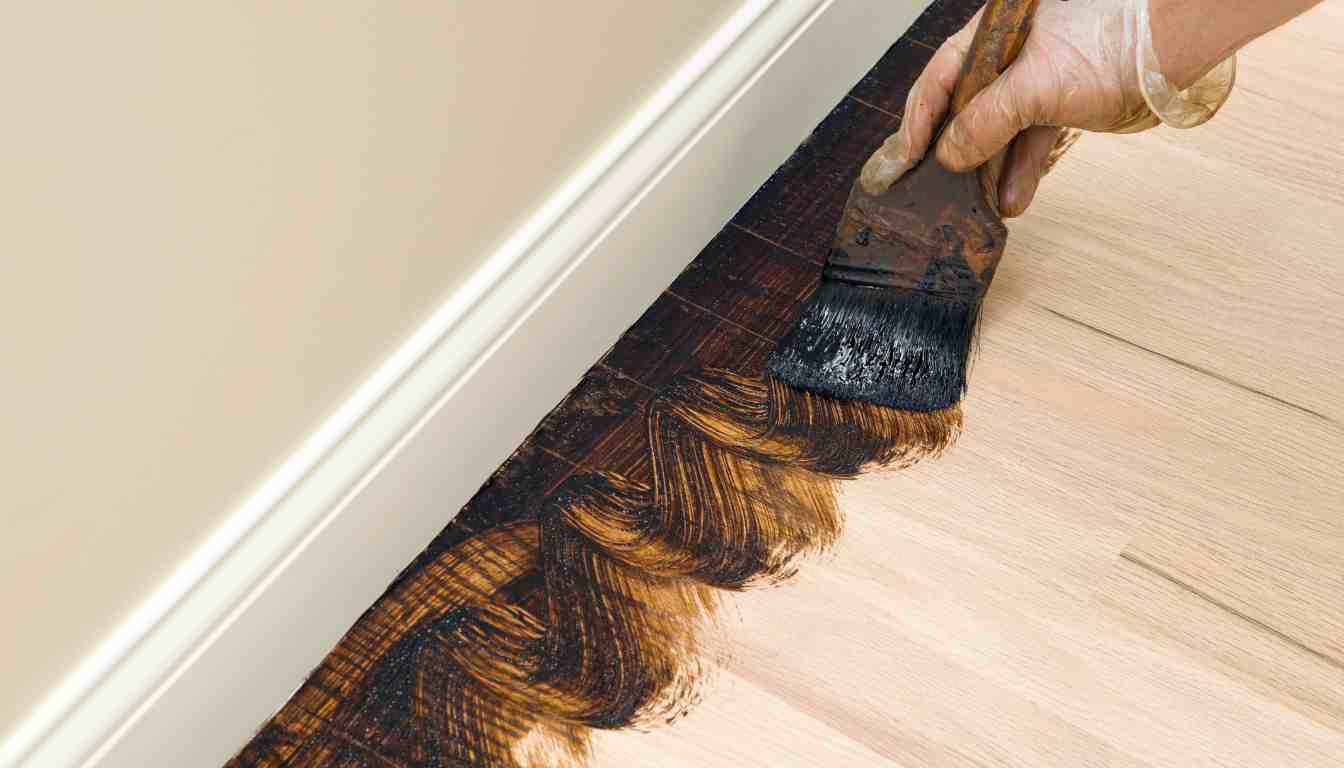To stain oak floors dark, sand down to bare wood, then apply a dark wood stain evenly. Dark stained hardwood floors have become increasingly popular due to their deep and rich appearance.
Many individuals are opting for this style as it complements various interior designs and adds a touch of elegance to any space. Staining oak floors dark can transform the look of a room, giving it a sophisticated and modern vibe.
Whether you are refinishing existing floors or installing new ones, dark stained hardwood floors can make a bold statement and elevate the overall aesthetic of your home. With the right techniques and products, achieving a beautifully dark-stained oak floor is a rewarding project that can enhance the visual appeal of your living space.

Credit: www.amazon.com
Choosing The Right Stain
When it comes to staining oak floors dark, selecting the right stain is a crucial decision. The choice of stain can significantly impact the final look and feel of your hardwood floors.
Popular Dark Stain Options
- Dark Walnut: Provides a rich, deep brown finish.
- Special Walnut: Offers a warm, medium-brown tone.
- Ebony: Creates a dramatic, almost black color.
Effects Of Stain On Oak Floors
Staining oak floors dark can enhance the grain pattern and add depth to the wood, giving it a timeless and luxurious appeal. The right stain can also help camouflage any imperfections and create a cohesive look throughout your space.
Staining Techniques
Staining Techniques: When it comes to staining oak floors dark, mastering the staining techniques is crucial for achieving the desired color and finish.
DIY Staining Methods:
For a DIY approach to staining oak floors dark, there are several methods that can be effective:
- Preparation: Sand down the floors to bare wood for optimal staining results.
- Stain Application: Use a roller or brush to apply the stain evenly across the floor surface.
- Finishing: Seal the stained floors with a protective finish to enhance durability.
Professional Staining Process:
When hiring professionals for staining oak floors dark, the process typically involves:
- Assessment: Professionals assess the condition of the floors and recommend suitable staining options.
- Preparation: Proper sanding and cleaning of the floors to ensure a smooth surface for staining.
- Stain Selection: Expert guidance on choosing the right stain color based on the desired outcome.
- Application: Skilled application of the stain for consistent and professional results.
- Finishing Touches: Applying a top coat or finish to protect the stained floors and enhance longevity.
Considerations Before Staining
Looking to stain oak floors dark? Ensure the wood is thoroughly sanded to achieve a clean surface for an even finish. Consider the amount of natural light in the room, as dark floors can make a space feel even darker if there’s limited sunlight.
Additionally, dark flooring can enhance the contrast with lighter furnishings.
Before you embark on the task of staining your oak floors dark, it’s crucial to consider a few factors that can significantly impact the outcome. From the necessity of sanding to the potential impact on room lighting, these considerations can guide you in making an informed decision.
Necessity of Sanding
Sanding is a crucial step before staining oak floors dark. It involves stripping the existing finish and exposing the bare wood for the new stain to penetrate evenly. Standard stain application requires thorough sanding down to the bare wood, ensuring any imperfections are revealed and addressed before the staining process. Following the sanding process, screening helps in smoothing out any scratches left by the sander, ensuring a flawless surface for the staining process.
Impact on Room Lighting
The color of your oak floors can have a significant impact on the lighting in the room. Dark floors tend to absorb more light, making the room appear cozier and more intimate. Conversely, in spaces with limited natural light, dark flooring can further darken the room. Therefore, it’s essential to consider the natural lighting in the room before opting for a dark stain on your oak floors.
By carefully considering these factors before proceeding with staining, you can ensure a successful and visually appealing outcome for your oak floors.
Pros And Cons Of Dark Oak Floors
Dark oak floors offer a luxurious aesthetic and timeless appeal when stained dark, enhancing the richness of the wood. However, they may show scratches and imperfections more prominently compared to lighter stains. To maintain their allure, regular maintenance and care are essential for preserving their beauty.
Enhancing Interior Design
One of the major advantages of staining oak floors dark is how it enhances the overall interior design of a space. Dark oak floors create a sophisticated and elegant look that adds depth and richness to any room. The deep, luxurious tones of dark stain can complement a variety of interior design styles, from modern and contemporary to traditional and rustic. The darker color adds drama and creates a focal point, making the floor a standout feature of the room.
Another benefit of dark oak floors is that they can create a sense of continuity throughout the house. They provide a cohesive look when combined with dark furniture or other elements in the space. Additionally, dark floors can make a room appear larger, especially when paired with light-colored walls and furnishings. They create a contrast that adds visual interest and dimension to the overall design.
Resale Value And Maintenance
Dark oak floors can also have a positive impact on the resale value of a home. Many homebuyers prefer the sophisticated and upscale look that dark floors offer. They can give a property a higher-end feel and attract potential buyers who are looking for a luxurious touch.
In terms of maintenance, dark oak floors can be advantageous. Unlike light-colored floors, dark oak floors are less likely to show dirt, dust, and stains, making them easier to maintain and keep clean. Additionally, scratches and imperfections are less visible on darker floors, making them a practical choice for high-traffic areas and homes with pets or children.
However, it’s important to note that dark oak floors may require more frequent cleaning to keep them looking their best. Dust and footprints can be more noticeable on dark surfaces, so regular sweeping or vacuuming is necessary to maintain their appearance. It’s also essential to use the appropriate cleaning products and techniques to prevent damage to the stain and finish.
Expert Advice And Recommendations
Elevate your space by expertly staining oak floors dark for a sophisticated ambiance. Enhance your interior with professional advice and top-notch recommendations for achieving stunning results.
When it comes to staining oak floors dark, it’s important to seek expert advice and recommendations to achieve the desired results. There are common misconceptions that need to be addressed, and consulting flooring professionals can provide valuable insights. Let’s explore these aspects in detail.
Addressing Common Misconceptions
There are a few common misconceptions when it comes to staining oak floors dark. Some people believe that staining can be done without sanding the floors beforehand. However, standard stain application requires sanding down to the bare wood to reveal any imperfections and ensure a smooth surface. Sanding also helps to remove any previous finishes or coatings that may hinder the staining process.
Another misconception is that dark floors darken a room. While it’s true that dark flooring can create a dramatic and sophisticated look, it doesn’t necessarily make a room darker. The amount of natural light in the space plays a significant role in how the floor color is perceived. If your home lacks natural light, dark floors might make the space feel even darker. It’s essential to consider the lighting conditions in your room before deciding on a dark stain.
Consulting flooring professionals is highly recommended when staining oak floors dark. These experts have the knowledge and experience to guide you through the process and make appropriate recommendations. They can assess the condition of your floor, suggest suitable stain colors, and provide tips on proper application techniques. Relying on their expertise will ensure that your stained oak floors turn out beautifully and stand the test of time.
Frequently Asked Questions Of Staining Oak Floors Dark
Can Oak Floors Be Stained Darker?
Yes, oak floors can be stained darker. It’s a process that involves sanding and applying a darker stain to achieve the desired shade. Staining oak floors darker is a popular trend and can be done to enhance the appearance of the hardwood.
Do I Have To Sand My Hardwood Floors Before Staining?
Yes, sanding your hardwood floors before staining is necessary. Sanding removes imperfections and smoothens the surface, ensuring a better finish. It is an important step in the staining process.
Do Dark Floors Darken A Room?
Dark floors can make a room feel darker if there is limited natural light. However, they can also enhance the contrast with lighter furnishings, making them a popular choice.
Are Lighter Or Darker Floors More Popular?
Dark hardwood flooring is in style, making it easier to sell your home and boosting resale value. It also complements lighter furnishings, enhancing the room’s aesthetic.
Conclusion
Staining oak floors dark can dramatically enhance the look of your space, creating a timeless and sophisticated ambiance. When choosing a stain, take into account the lighting and decor to achieve the desired aesthetic. Proper preparation and application are essential for a flawless finish.
Embrace the allure of dark-stained hardwood floors.


